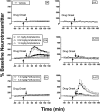Abuse-Related Neurochemical Effects of Para-Substituted Methcathinone Analogs in Rats: Microdialysis Studies of Nucleus Accumbens Dopamine and Serotonin
- PMID: 26645638
- PMCID: PMC4702071
- DOI: 10.1124/jpet.115.229559
Abuse-Related Neurochemical Effects of Para-Substituted Methcathinone Analogs in Rats: Microdialysis Studies of Nucleus Accumbens Dopamine and Serotonin
Abstract
Methcathinone (MCAT) is a monoamine releaser and parent compound to a new class of designer drugs that includes the synthetic cathinones mephedrone and flephedrone. Using MCAT and a series of para-substituted (or 4-substituted) MCAT analogs, it has been previously shown that expression of abuse-related behavioral effects in rats correlates both with the volume of the para substituent and in vitro neurochemical selectivity to promote monoamine release via the dopamine (DA) versus serotonin (5-HT) transporters in rat brain synaptosomes. The present study used in vivo microdialysis to determine the relationship between these previous measures and the in vivo neurochemical selectivity of these compounds to alter nucleus accumbens (NAc) DA and 5-HT levels. Male Sprague-Dawley rats were implanted with bilateral guide cannulae targeting the NAc. MCAT and five para-substituted analogs (4-F, 4-Cl, 4-Br, 4-CH3, and 4-OCH3) produced dose- and time-dependent increases in NAc DA and/or 5-HT levels. Selectivity was determined as the dose required to increase peak 5-HT levels by 250% divided by the dose required to increase peak DA levels by 250%. This measure of in vivo neurochemical selectivity varied across compounds and correlated with 1) in vivo expression of abuse-related behavioral effects (r = 0.89, P = 0.02); 2) in vitro selectivity to promote monoamine release via DA and 5-HT transporters (r = 0.95, P < 0.01); and 3) molecular volume of the para substituent (r = -0.85, P = 0.03). These results support a relationship between these molecular, neurochemical, and behavioral measures and support a role for molecular structure as a determinant of abuse-related neurochemical and behavioral effects of MCAT analogs.
Copyright © 2015 by The American Society for Pharmacology and Experimental Therapeutics.
Figures







References
-
- Baumann MH, Ayestas MA, Dersch CM, Brockington A, Rice KC, Rothman RB. (2000) Effects of phentermine and fenfluramine on extracellular dopamine and serotonin in rat nucleus accumbens: therapeutic implications. Synapse 36:102–113. - PubMed
Publication types
MeSH terms
Substances
Grants and funding
LinkOut - more resources
Full Text Sources
Other Literature Sources
Medical

